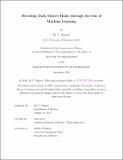Decoding Dark Matter Halos through the Lens of Machine Learning
Author(s)
Nguyen, Tri V.
DownloadThesis PDF (30.59Mb)
Advisor
Necib, Lina
Terms of use
Metadata
Show full item recordAbstract
Dark matter (DM) constitutes about 85% of the matter in the Universe, yet its particle nature remains one of the greatest outstanding questions in astrophysics. DM halos act as the scaffolding within which galaxies form, but the specific mechanisms through which they influence galaxy evolution are not fully understood, especially at galactic scales. While cosmological simulations and astrophysical surveys have made significant strides in constraining DM properties, upcoming surveys will generate terabytes of complex, high-dimensional data. It is thus imperative to develop new methodologies capable of interpreting and linking this data with theoretical models. Machine learning techniques, coupled with advancements in cosmological simulations, present a transformative opportunity. In this thesis, I conduct a multi-scale investigation into the nature of DM and its role in shaping galaxies by integrating advanced machine-learning techniques with cutting-edge cosmological simulations. First, I employ simulation-based inference and graph neural networks to infer the mass density profiles of DM halos in dwarf galaxies from their stellar kinematics. Next, I develop a generative model using normalizing flows and recurrent neural networks to reconstruct the mass assembly histories of DM halos in cosmological simulations. Furthermore, I utilize variational diffusion models and Transformer-based neural networks to perform point-cloud modeling of satellite populations under alternative DM models. Finally, I create synthetic surveys for the Gaia surveys from Milky Way-like simulations, bridging the gap between simulations and observations. This thesis demonstrates the transformative potential of machine learning techniques to probe the DM properties and galaxy formation. The methodologies developed herein provide new avenues for interpreting vast and complex astronomical datasets and offer insights that could lead to a deeper understanding of the fundamental nature of DM.
Date issued
2024-09Department
Massachusetts Institute of Technology. Department of PhysicsPublisher
Massachusetts Institute of Technology